It’s one of the biggest questions in the world of biblical archaeology: Who was the pharaoh of the Exodus? We explored this question in detail in the March-April 2023 issue of Let the Stones Speak (read it here). But what about Pharaoh’s archrival? Is there evidence for Moses in ancient Egypt?
For skeptics, the answer is simple: No. Moses is a fictional biblical character for whom we have no material evidence. Others might give a more nuanced version of “No,” one that recognizes the remarkable Egyptianisms throughout the Torah that hint at the author’s familiarity with Egyptian culture (see “Searching for Egypt in Israel”). But is it true—is there really no evidence of Moses himself?
There is one particular princely individual in New Kingdom Period Egyptian history who, in many respects, remarkably parallels the biblical account of Moses. The similarities are so close, one key proponent believes the evidence is secure—that this individual is “the very same man known as Moses, traditional author of the Old Testament book of Exodus and the other four books of the Pentateuch. Boom. Period.”
Has the question of Moses’s identity in Egyptian history been solved?
Laying the Groundwork
First, we need a basic chronological framework. As we established in “Who Was the Pharaoh of the Exodus?”, biblical chronology puts the Exodus in the 15th century b.c.e. Granted, there is significant debate on this issue; our article explains this time frame in detail (see here, here and here for additional information on this subject). In short, 1 Kings 6:1 states that 480 years elapsed between the Exodus and the construction of Solomon’s temple, which is widely recognized as beginning in 967 b.c.e. (explained here). This places the Exodus at 1446 b.c.e.; Israel’s entrance into Canaan 40 years later, in 1406 b.c.e.; and the conquest of Canaan at the end of the century, on into the 14th century b.c.e. Several other biblical passages point to this same general time frame (e.g. Judges 11:26 and 1 Chronicles 6).
This time frame for the Exodus, based on the biblical text, aligns remarkably well with clues from the archaeological record. For example, in the “Amarna Letters” (14th century b.c.e.), panicked Canaanite leaders describe an invading people referred to as “Habiru” (i.e. Hebrews) progressively taking “all the lands” (see our article, “The Amarna Letters: Proof of Israel’s Invasion of Canaan?”).
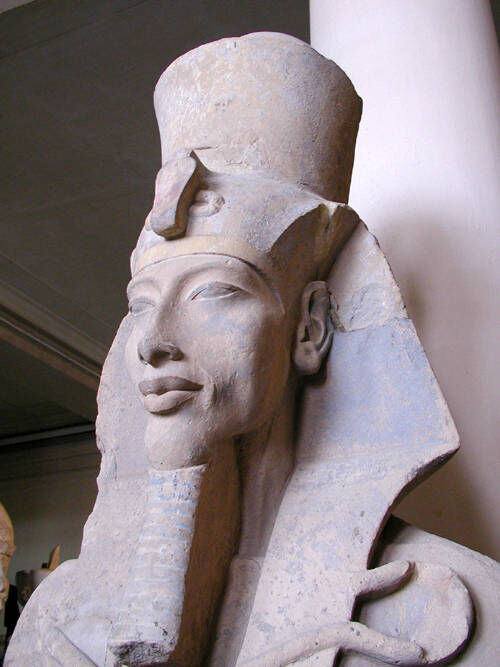
This overall chronological picture also matches remarkably well with the general progression of Egyptian history. As outlined in “Who Was the Pharaoh of the Exodus?”, following a high chronology timeline puts the pacifist Amarna period pharaoh, Amenhotep iv/Akhenaten, as the pharaoh during the conquest of Canaan (a pharaoh also notable for his upheaval of Egypt’s polytheistic religious system and rejection of the name “Amenhotep”). It places his father, Amenhotep iii, as pharaoh of the wilderness sojourn—another notably pacifist pharaoh, from whose reign we find our earliest archaeological reference to “yhwh” as being worshiped by nomads east of Egypt. (Amenhotep iii’s reign is also notable for an emphasis on Sekhmet, the goddess of healing.) And this puts his father, Thutmose iv, as sudden successor to the Exodus pharaoh—Thutmose iv was a non-firstborn, who assumed the throne under dubious circumstances (as justified on his Dream Stele).
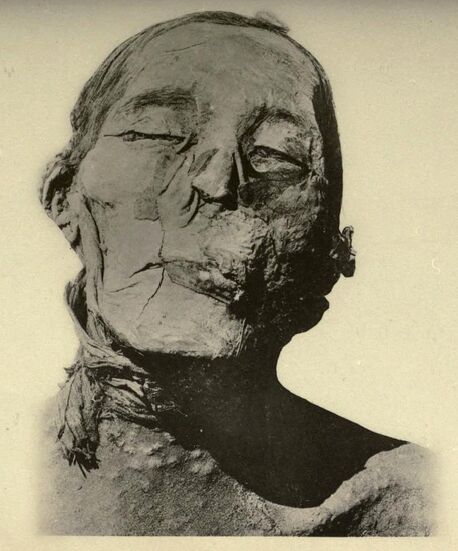
This makes Amenhotep ii (also a non-firstborn) our pharaoh of the Exodus. Interestingly, the third-century b.c.e. Egyptian priest-historian Manetho and first-century c.e. Egyptian priest Chaeremon both identify the Exodus pharaoh by the name “Amenophis”—the later Greek form of Amenhotep. Amenhotep ii’s reign began with remarkable fury and conquest, with the pharaoh swiftly making a name for himself for his level of sadistic cruelty. Yet this is a pharaoh for whom we know next-to-nothing about the latter part of his reign—save for a warning to his viceroy to be wary of foreigners and magicians (the Semna Stele of Usersatet). That, and a mummified body—if it is really his—covered in peculiar tubercles.

This in turn makes Amenhotep ii’s father, Thutmose iii—arguably Egypt’s greatest pharaoh, and one of its longest-reigning (at 54 years)—the primary pharaoh of the oppression, during whose tenure Moses fled into the wilderness for 40 years. It puts Thutmose iii’s stepmother, Hatshepsut, as the biblical “pharaoh’s daughter”—a woman who went on to become a powerful ruler in her own right, yet one whose inscriptions attest to a “heart full of love,” whose “spirits inclined toward foreign people” (and whose monuments, strangely enough, were vandalized and defaced during the rule of our Exodus pharaoh, Amenhotep ii). It puts her sickly husband and half-brother, Thutmose ii (father of Thutmose iii) and their father, Thutmose i, as the former rulers of Egypt, leading the land as described in the first part of Exodus 2.

Finally, in this scheme, I would submit that it puts Thutmose i’s predecessor, Kamose, as the king of Exodus 1 who “knew not Joseph.” Kamose was a pharaoh of southern Egypt, who initiated a campaign to overthrow the foreign Semitic rulers of northern Egypt and bring the Delta under sole Egyptian rule, with a decree (the Carnarvon Tablet) reading remarkably similar to Exodus 1:8-10. (Kamose was killed during battle, but the overthrow was completed by his brother Ahmose i, who initiated the New Kingdom Period and 18th Dynasty of Egypt. See here for more detail.)
Within this framework, we can now focus in on the period in question—namely the late 16th century b.c.e., with the princess-cum-queen/Pharaoh Hatshepsut, and the remarkable rags-to-riches—to disappearance—story of a princely figure within her administration.
Hatshepsut: Egypt’s Greatest ‘Pharaoh’s Daughter’
The Bible states that Moses lived 120 years and that his lifespan was divided into three equal parts. He spent his first 40 years as a prince in Egypt, then another 40 years as an outcast in Midian, and the final 40 years as leader of the Israelites (Exodus 7:7; Numbers 14:33; Deuteronomy 29:4; 34:7, etc). Moses died just prior to the Israelites crossing into the Promised Land (Deuteronomy 31:2). Applying this detail to Israel’s entry date into Canaan (circa 1406 b.c.e.) places Moses’s birth at around 1526 b.c.e.

This would place his birth somewhere within the reign of Pharaoh Thutmose i. Within a fairly typical high chronology framework, the reign of Thutmose i is dated to 1526–1512 b.c.e. Prof. Douglas Petrovich provides a slightly earlier time frame, circa 1529–1516 b.c.e. Antonio Crasto provides an even earlier reign, circa 1532–1519 b.c.e.
The royal family of Thutmose i is extremely interesting. This pharaoh sired a fully royal daughter, Hatshepsut—born through his Great Royal Wife Ahmose—and a half-royal son, Thutmose ii—born through his minor wife, Mutnofret. In order to secure his son’s place on Egypt’s throne, the dying Thutmose i had his 18-year-old son marry his 24-year-old half-sister. (See Sidebar 2 for detail about another interesting member of this family, with possible connection to the biblical account.)

The repeated biblical emphasis on this pharaoh’s daughter is doubly interesting in the context of the court intrigue at this time. After all, this was the same emphasis placed on Hatshepsut as the fully-royal daughter of the pharaoh; it was also a position and title Hatshepsut continued to highlight on her monuments during her reign, long after her father Thutmose i’s death.
Applying standard high chronology dates, Hatshepsut was about 10 years old at the time of the biblical Moses’s “discovery.” Petrovich puts her at 12 years old, and applying Crasto’s chronology to our dates for Moses and the Exodus would make her around 15 years old.
Thutmose ii’s reign, with Hatshepsut as his sister-queen, was neither long nor impressive. He was a sickly pharaoh, who did not produce a male heir through Hatshepsut (instead, she bore him a daughter, Neferure). Like his father, Thutmose ii, however, did bear a male heir—Thutmose iii—through a concubine (Iset).
Thutmose iii was just 2 years old when his father died. As such, his stepmother Hatshepsut initiated a 22-year coregency, during which she became a truly remarkable pharaoh in her own right.
Egyptologist Sir William Flinders Petrie, the “father of Egyptian archaeology” (1853–1942), noted that Pharaoh Hatshepsut’s “activity seems to have been entirely given to peaceful enterprises” in “an age of tranquility to the realm” (A History of Egypt, Vol. ii). One remarkable inscription on the facade of her temple at Speos Artemidos reads, in part: “[M]y spirits inclined toward foreign people … the people Roshau and Iuu did not hide themselves from me” (emphasis added throughout). Another inscription describes a “heart full of love.” These extraordinary sentiments fit well with the biblical description of a “pharaoh’s daughter” who would bring up a foreign child from poverty and catapult him into princedom.
Coincidentally, during the reign of Hatshepsut, a “commoner” was catapulted in rank to the highest levels of Egyptian administration and princedom.
Introducing ‘Mother’s Brother’
Egyptian history clearly shows this man was of decidedly non-royal, common origin. Yet by the end of his life in Egypt—prior to his mysterious disappearance in the early-mid 1480s b.c.e.—he had risen to the highest ranks of Egyptian society.
This prince is referred to commonly as Senenmut (alternatively, Senmut). Author and investigative journalist Scott Alan Roberts identifies this individual as none other than Moses himself. (Antonio Crasto likewise identifies him as Moses in his Italian-language article “Senenmut.”)

“Let’s cut to the quick. Senenmut, favored courtier to Pharaoh Hatshepsut, is the very same man we know as Moses,” Roberts states in his 2014 book The Exodus Reality (coauthored with John Richard Ward). “Senenmut lived under the gracious and benevolent eye of Hatshepsut, some accounts even hailing to their relationship as possible lovers, despite the nearly 10-year age difference between them.”
This originally non-royal individual stunningly came to be “granted nearly 90 titles bestowed on him by Hatshepsut, including Hereditary Crowned Prince of Egypt, Count, Sole Companion, Master of All People, Chief of the Whole Land, Royal Vizier, and Chief Royal Architect. …
Senenmut’s royal appointments included: chief steward who conducted all the works of the king … confidant of the king, privy councilor of the right hand, chief steward of the Princess Nefrure [Hatshepsut’s daughter]. Senenmut’s administrative titles included: wearer of the royal seal, steward of Amun, overseer of the granary of Amun, overseer of the storehouse of Amun …. Senenmut’s religious titles included: … chief of the prophets of Montu in Hermonthis.

As summarized in Hatshepsut: From Queen to Pharaoh (edited by Catharine Roehrig, Renée Dreyfus and Cathleen Keller), “Senenmut held so many offices that it is difficult to see how he was capable of carrying out even a fraction of the duties associated with them.”
In interrogating whether or not this individual is the biblical figure Moses, our first question, of course, must concern the name. If these are one and the same individual, why not “Moses”? According to Roberts, “A significant title she [Hatshepsut] bestowed … was in the changing of his name to Senenmut, which means ‘mother’s brother.’ In essence, it was a title elevating a son to the status of equal with his mother, allowing him to claim equal status of ‘brother to the gods’ with this pharaonic parent.”
Egyptian leaders commonly bore several names (one of the things that makes cross-identification between ancient sources especially difficult). The Egyptian historian Manetho describes Moses as using an entirely different Egyptian name in the Egyptian courts, while being referred to as “Moses” specifically by the Israelites (as quoted by first-century Jewish historian Josephus—Against Apion 1.26). The Egyptian priest Chaeremon records the same—that the name “Moses” was only used among the Israelites (Against Apion 1.32).

But wasn’t the name Moses an Egyptian name anyway—akin to the various Egyptian royals whose names end with -mose/-mosis? This is a common interpretation. Yet it is one that Egyptologist Prof. Kenneth Kitchen argues strenuously against. Instead, based upon the spelling of the name and the biblical etymology provided in Exodus 2:10, he argues that “Moses” was actually a strictly Hebrew name (and that this naming decision came through his mother, who served as hired nurse for the pharaoh’s daughter). As he summarized in his 2003 book On the Reliability of the Old Testament:
[Moses’s] name is widely held to be Egyptian, and its form is too often misinterpreted by biblical scholars. It is frequently equated with the Egyptian word ms (Mose) meaning “child,” and stated to be an abbreviation of a name compounded with that of a deity whose name has been omitted. And indeed, we have many Egyptians called Amen-mose, Ptah-mose, Ra-mose, Hor-mose, and so on. But this explanation is wrong. …
The name of Moses is most likely not Egyptian in the first place! The sibilants do not match as they should, and this cannot be explained away. Overwhelmingly, Egyptian s appears as s (samekh [ס]) in Hebrew and West Semitic, while Hebrew and West Semitic s (samekh) appears as tj in Egyptian. Conversely, Egyptian sh = Hebrew sh [ש, as in the name of Moses, משה], and vice versa. It is better to admit that the child was named (Exod. 2:10b) by his own mother, in a form originally vocalized Mashu, “one drawn out” (which became Moshe, “he who draws out,” i.e., his people from slavery, when he led them forth).
If correct, this would explain the assertions of Manetho and Chaeremon—that the name “Moses” was used specifically among the Israelites, rather than among the Egyptians. It would also logically require looking for an individual of a different name in Egyptian history—one fitting the description of Moses’s life, rather than biblical Hebrew name.
And in this overall context of Moses’s adoption, the otherwise-unusual name “Senenmut” would make sense, befitting an adoptive child of the young pharaoh’s daughter—in this case, with Hatshepsut recognizing herself figuratively as both “mother” and “sibling” to this individual (alongside conferring upon him divine privilege).
To this end, another interesting name connection might be found in the New Testament. Hebrews 11:24-25 read: “By faith Moses, when he had become great, refused to be called son of Pharaoh’s daughter; choosing rather to suffer affliction along with the people of God” (Darby Bible Translation). To be “called ‘son of Pharaoh’s daughter,’” at first glance, might appear to simply be a passing reference to Moses’s adoptive status. But could it be a hint toward the actual name of Moses in the Egyptian courts—what he was literally “called”—with a name such as “Mother’s Brother”? A title eventually renounced by him, after “he had become great”—casting his lot in with his Hebrew brethren?
Humble Origins
Senenmut’s humble origins—prior to his “becoming great”—are widely recognized. His parents carried no royal titles, and his father—who died prior to his rise to any significant power—was initially given a very simple burial. Continuing from Hatshepsut: From Queen to Pharaoh: “Senenmut may justifiably be described as one of the most eminent and influential personages of the 18th Dynasty, yet nothing about his beginnings suggests future greatness. His parents were of relatively lowly origin and neither seems to have risen to prominence or held any administrative or religious office.” It seems that as Senenmut grew in power, he was gradually able to afford them a somewhat better reburial.
Still, mystery surrounds his family, including his parents, referred to simply as “Ramose and Hatnofer” (Ramose, perhaps not greatly dissimilar to the biblical name for Moses’s father, Am-ram; in this vein, compare the biblical name of Moses’s sister, Miriam, to its postulated Egyptian equivalent, Meri-Amun). These parents of Senenmut are sometimes described as “provincial” or “peasants.” Roehrig et al. continue (in the context of Senenmut’s parents and relatives): “Indeed, there is much we do not know about population groups in Egypt. Three women from the Levant were taken into the harem of Thutmose iii; their ethnic identity would not have been learned had their West Semitic names not been written on their funerary goods. However, immigrants often took Egyptian names, or their names were not recorded at all, leaving us only their bodies, possessions, and possibly grave types to tell their story. What are we to make for instance, for the women with braided hair buried quite simply in the tomb of Senenmut’s parents?” Further, of their internment, “two rectangular coffins contained six additional mummies, all anonymous and almost certainly close family members.”
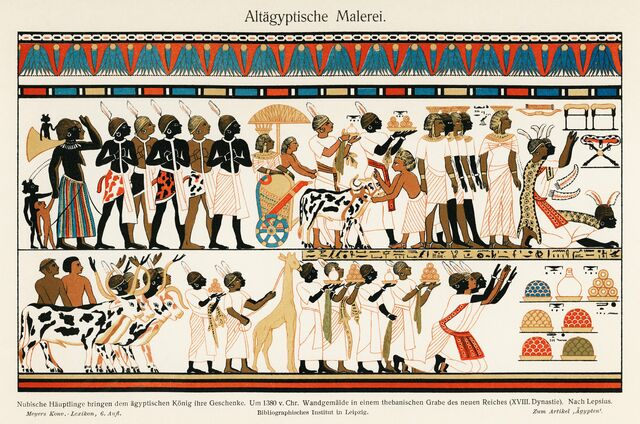
It appears that Senenmut’s gradual rise to power began during the reign of Hatshepsut’s father, Thutmose i (thus the biblical “pharaoh” of the “pharaoh’s daughter”). And part of his initial rise appears to be in the context of military prowess against the Ethiopians.
Senenmut’s Exploits
Senenmut appears to have risen through the ranks in military service from his late teens onward. Crasto notes that he participated in military campaigns in the land of Kush (Ethiopia), where he appears to have attained rank, perhaps as “brigade commander.” For those familiar with the classical accounts of Moses’s life, this is significant—because while his exploits in Ethiopia are not mentioned in the Bible (with only the faintest hint given in Numbers 12:1), they are mentioned, at length, by certain classical historians.
Josephus dedicates an entire chapter of Antiquities of the Jews to Moses’s military exploits in Ethiopia (Antiquities 2.10). A similar account comes from the third-century b.c.e. Jewish historian Artapanus. (See our article, “Evidence of Moses’s ‘Conquest of Ethiopia?’”)
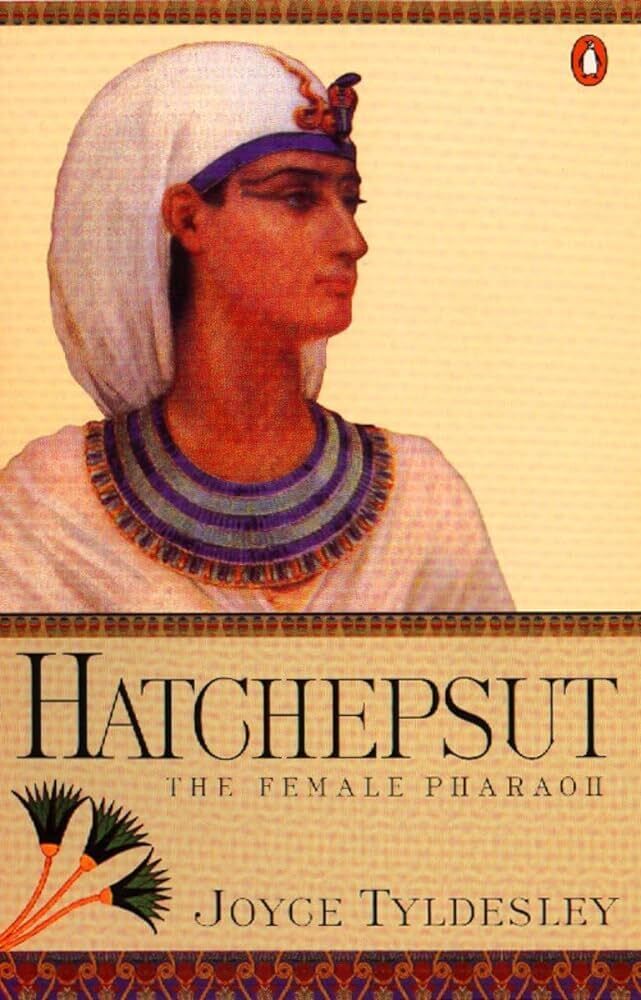
It was not, however, until Hatshepsut came to power that Senenmut began to be catapulted in rank with the litany of titles she applied to him—so much so, that Egyptologist Prof. Joyce Tyldesley refers to him as the “Greatest of the Great” in the court of Hatshepsut, her “most influential courtier” (Hatchepsut: The Female Pharaoh). “Effectively, Senenmut was ruler of Egypt,” she writes.
The greatest sign of how incredibly close these two were—Senenmut and Hatshepsut—was the proximity between Senenmut and the daughter of Hatshepsut, Neferure, whom he tutored. Several statues depict the young princess Neferure sitting in his lap. Normally, non-royals were not allowed in the close presence of royalty, let alone the daughter of a pharaoh. “[T]he representation in sculpture of a royal [Neferure] and a nonroyal [Senenmut] person together is unprecedented and abrogates a number of seemingly inviolate rules of Egyptian art,” Roehrig et al. explain. “These include the general conventions that a royal person, even a child, is represented in a larger scale than non-royalty; that a royal individual is never touched except by another royal person or a deity; and that a royal person never interacts in an obvious way with (let alone touches) a person of lower rank.”
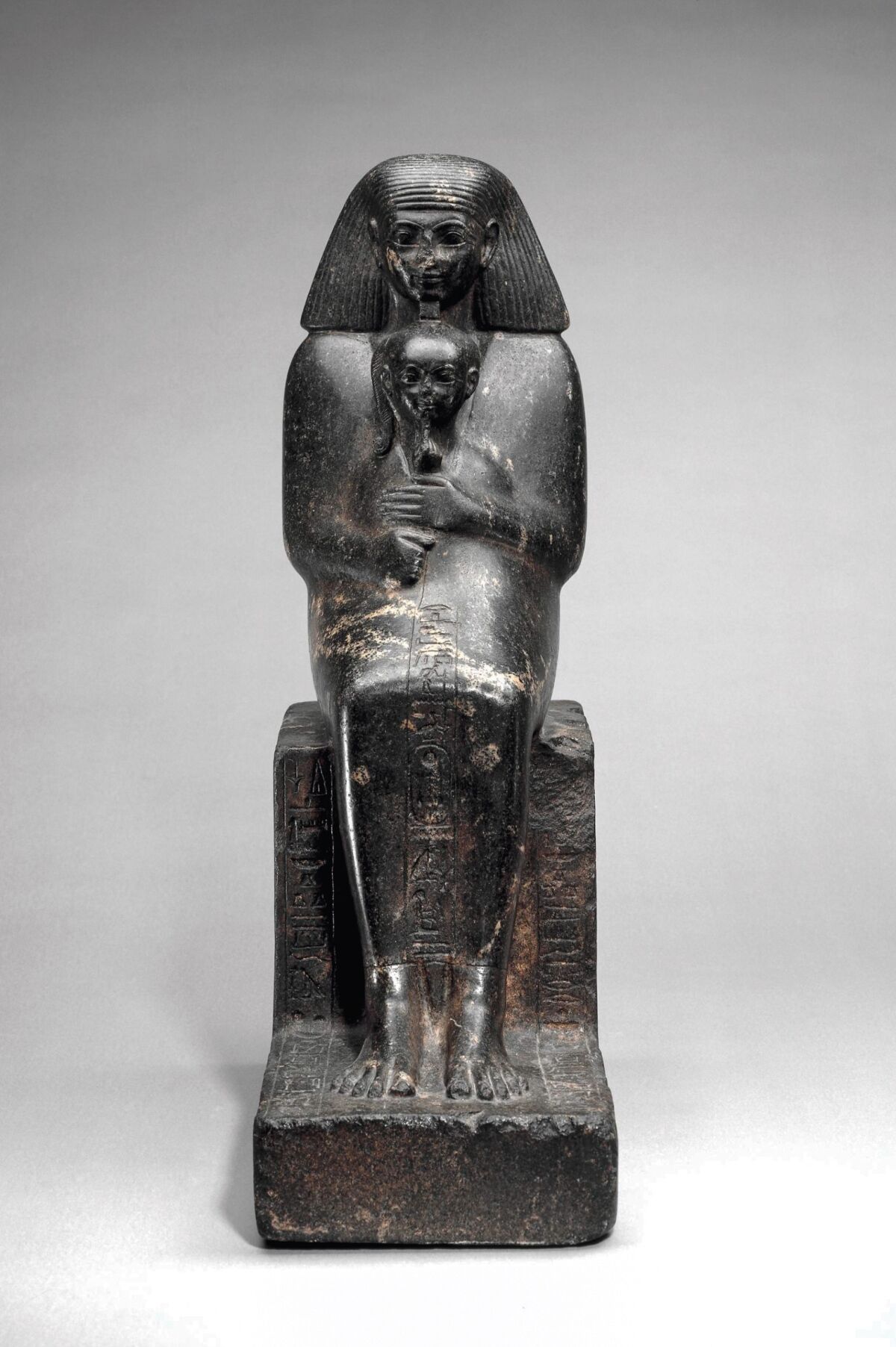
T. George Allen, in his 1927 article “A Unique Statue of Senmut,” calls these statues a “startling innovation. That he [Senenmut], an ordinary, non-royal person, should venture to have himself portrayed, and not once but five times at least, in such intimate association with a scion of god-descended royalty, is a final proof of his queen’s unparalleled graciousness.”
Even the general quantity of statues relating to this man are remarkable. “Because so many of Senenmut’s statues have survived—the size of his corpus is paralleled only by that of royalty” (Hatshepsut: From Queen to Pharaoh). Yet, “[l]acking distinguished lineage, Senenmut could not, like some of his illustrious contemporaries, suggest his participation in a cycle of eternal renewal by depicting his extended family. Nor did he, apparently, have any children, so there would be no future generations to maintain his funerary cult; he stood alone” (ibid).
This is another remarkable peculiarity that is often pointed out, for an individual in such high office: his lack of wife and children. But this again matches perfectly with the biblical portrayal of Moses while in the courts of Egypt.
Still, Senenmut’s closeness to the queen naturally led to rumors of an affair between them. To this day, a lewd graffito can be found of them, left by an ancient workman on a hidden stone surface at Deir el-Bahari. Nevertheless, theories of a “romantic connection” between Hatshepsut and Senenmut were largely debunked in Peter Dorman’s 1988 study, The Monuments of Senenmut: Problems in Historical Methodology.
Royal Architect
One of the greatest achievements attributed to Senenmut is in his role as royal architect, overseeing the construction of Hatshepsut’s grand mortuary complex at Deir el-Bahari. This complex, built against a cliff face, remains one of the veritable wonders of the ancient world, known for its architectural proportioning and perfection. It consists of a large, colonnaded courtyard complex centered around an inner sanctum “Djeser Djeseru” (“Holy of Holies”).
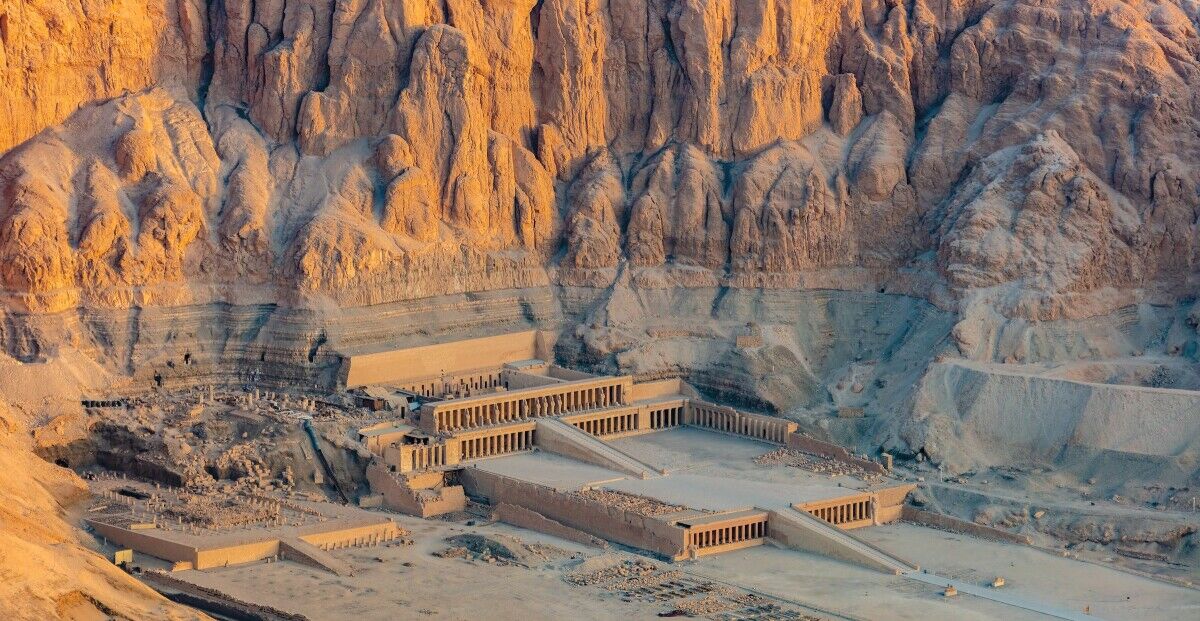
Such architectural connections are also interesting in light of the biblical Moses. Moses, of course, oversaw the construction of the tabernacle, as well as the construction of another “pillared” complex in the desert against a mountainside (Exodus 24:4). Even the biblical account of Moses and the Hebrew workmen is interesting in light of this context (Exodus 2:11-14). What was Moses doing at this construction site, manned by Hebrews and Egyptians? Was Moses working in an administrative position, as “ruler and a judge,” primarily over the Egyptian workmen? (verse 14). Could this event have even taken place at a site like Deir el-Bahari?
In addition to the construction of Hatshepsut’s mortuary complex, like any high-ranking member of Egyptian administration, Senenmut had his own sufficiently respectable twin-tomb complex constructed (Tomb 71 and Tomb 353). These tombs contain several fascinating and unique features, such as a detailed star-map ceiling—the earliest star-map ever discovered in Egypt (leading to speculation that Senenmut was also an astronomer). Professor Tyldesley describes: “[T]he unique astronomical ceiling in his Tomb 353 … and the eclectic variety of texts and ostraca included in Tomb 71 (ranging from plans of the tomb itself through various calculations to the Story of Sinhue), certainly suggests that Senenmut was a cultured and well-rounded man with a wide range of interests extending far beyond his official duties.”
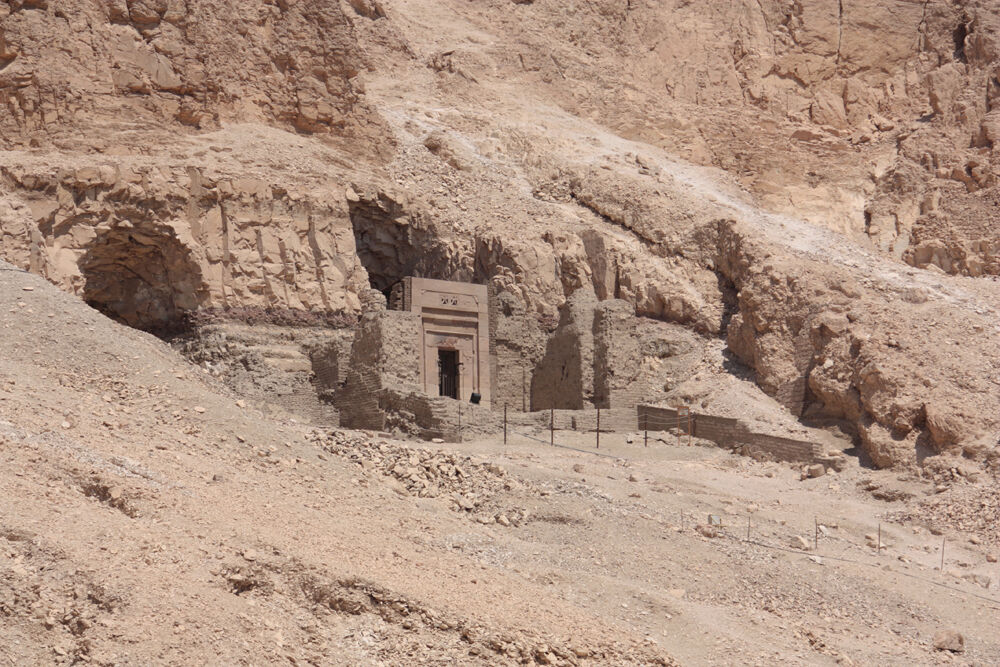
But Senenmut was never buried in his tomb. In fact, his tombs were never even finished but, instead, were prematurely closed. “[T]he decorated chamber in Tomb 353 was abandoned and sealed while still full of excavated chip and workmen’s tools, and his quartzite sarcophagus was left unfinished in the corridors of Tomb 71” (Hatshepsut: From Queen to Pharaoh).
It appears Senenmut, for whatever reason, completely disappeared without a trace.
Sudden Disappearance
“Senenmut’s sudden disappearance is one which has teased Egyptologists for decades, the lack of solid archaeological and textual evidence allowing the vivid imaginations of Senenmut-scholars to run wild, and resulting in a variety of fervently held solutions, some of which would do credit to any fictional murder-mystery plot,” Tyldesley continues.
A “murder-mystery plot”—words that might be more apropos than intended. Because this was, of course, the entire premise of Moses’s sudden disappearance from Egypt.
“[W]e have no dated references to Senenmut after year 18–19” of the Hatshepsut/Thutmose iii coregency (Hatshepsut: From Queen to Pharaoh). “He is shown with Princess Neferure on a stela of year 11, at Sinai, and the last dated document containing his name is an informal record of conscript labor, on an ostracon from year 16” (ibid).
Standard high chronology, which places the beginning of the Hatshepsut/Thutmose iii coregency circa 1504 b.c.e., would put this final mention of Senenmut at circa 1486 b.c.e.—the 40th year of our biblical Moses. (Applying other chronological variants, such as that of Petrovich and Crasto, would put this final discovered mention of Senenmut a few years earlier.)
Roberts notes this remarkable synchronism: “[S]omewhere around 1486–1485 b.c.e., Senenmut disappears completely off the Egyptian scene. Incidentally, if you’re keeping up on the mathematics, if Moses was born in 1526 b.c.e., he would have turned 40 in 1486 b.c.e., the same year he is said to have murdered the Egyptian taskmaster and fled Egypt—and the same approximate year that Senenmut completely disappears from Egypt. … [T]he chronology of his life is a perfect match. And the fact that he leaves without anything ever being said about it in the Egyptian record might be an indicator of who he truly is.”
But a clue as to where he went might be gleaned from his literature library. As mentioned, the 12th Dynasty Egyptian literary epic, the Story of Sinhue, was found in his tomb. This classic describes the protagonist, Sinhue, fleeing Egypt into the Levant in order to escape the pharaoh’s wrath, following the assassination of King Amenemhet i. It describes Sinhue dwelling with Bedouin and marrying the daughter of a chieftain.
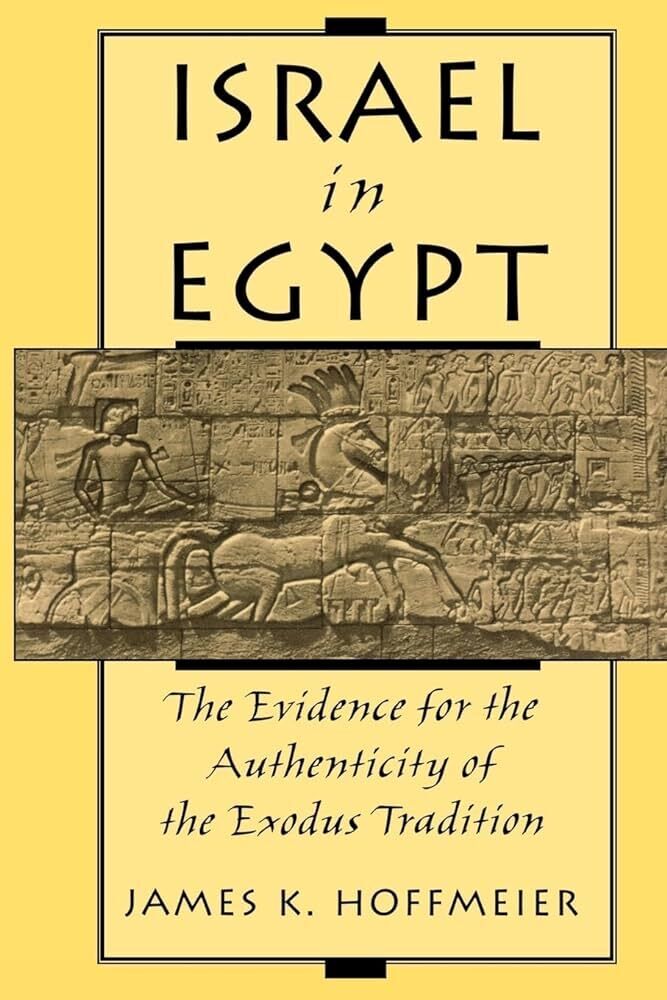
Egyptologist Prof. James Hoffmeier notes that, despite several key differences, “[t]hese same features are found in the story of Moses in Exodus. … These striking similarities between the main elements in the stories of Sinuhe and Moses have, surprisingly, not attracted the attention of biblical scholars” (Israel in Egypt: The Evidence for the Authenticity of the Exodus Tradition).
One wonders: Could Senenmut, who would have been familiar with this epic, have used it as a model for his own course of action in fleeing Egypt, following the murder of an Egyptian workman?

Damnatio Memoriae
The disappearance of Senenmut is not the end of the story. After his departure, many of his monuments and inscriptions suffered the curse of damnatio memoriae, intentional erasure (“damnation of memory”). It’s interesting too that the same fate befell the monuments of Hatshepsut.
“Senenmut suffered a series of posthumous attacks on his memory. … Like so much in the life of Senenmut, the reason for the attacks on inscriptions of his name remains for the moment a mystery” (Hatshepsut: From Queen to Pharaoh).
Egyptologist Prof. Alan Schulman wrote that “his two tombs … apparently had been thoroughly vandalized, with his name and portraits maliciously and vindictively expunged … the splendid quartzite sarcophagus which had been found in his first tomb (nr. 71) had been shattered into fragments …. [Senenmut] had been the victim of someone’s implacable hatred,” proposing Thutmose iii as responsible (“Some Remarks on the Alleged ‘Fall’ of Senmut,” 1969).
Roberts differs, with regards to such earlier theories of Thutmose iii as responsible for the damnatio memoriae of Senenmut and Hatshepsut. “[N]ewer information states that Thutmoses iii did not disgrace or remove any of her images … it was not done under the order of Thutmoses iii. It was his son, Amenhotep ii [our Pharaoh of the Exodus], who ordered their removal. And what’s even more interesting is that at the same time he removed the images of Hatshepsut, he also removes all images of … Senenmut” (ibid).
Why? A reconstruction of events following the biblical account of Moses and the “pharaoh’s daughter” would explain exactly why.
This damnatio memoriae was not entirely complete, however. Several of Senenmut’s statues and inscriptions survived—one of which bears the strange inscription: “The steward Senmut it is who has come forth from the flood and to whom has been given the inundation, that he may control it; even the Nile.”
Could this individual, after all, really be the individual of infamy, the man who was brought forth from the Nile—could it be Moses?
You will have to form your own opinion. Personally, I was initially skeptical. It seemed like a story “too good to be true” and one that would come apart in the details. Yet while there remain some unknowns, the more I research the history, the more plausible it becomes.
A level of skepticism was highlighted by Scott Roberts himself: “When I was in my seminary days under the professorship of Dr. Alin, I presented my theory that Moses was raised by Hatshepsut. Even back them, some 30 years ago, the good doctor advised me to use great care, because although the facts fit, the story borders on being far too romanticized, that Moses should be raised by the heir to the throne rather than what was more probable in his view: a harem wife or daughter.”
In the end, whatever your conclusion about Senenmut, the question of his identity as the biblical Moses is not the ultimate takeaway. Instead, it is the fact that this overall picture of late 16th-early 15th century b.c.e. Egypt—politically and religiously—is a precise fit for the biblical sequence of events, the milieu in which the biblical Moses could be raised by a Pharaoh’s daughter to become “prince of Egypt.”
In the words of Professor Tyldesley: “Gradually, as her reign progressed, Hatchepsut started to appoint new advisers, many of whom were men of relatively humble birth such as Senenmut.” Could another such individual within that administration have been the biblical Moses? It is certainly possible. Ultimately, however, this benevolence toward the “humble” and “foreigners” disappeared under the iron rule of Thutmose iii and Amenhotep ii, with the latter’s ultimate erasure of such, and his warnings against “foreigners.”
Is there no evidence for Moses in ancient Egypt? The answer isn’t as simple or straightforward as some might claim. Truth is, it’s a fascinating, multifaceted question, and one that brings to the fore some truly remarkable parallels between Egyptian history and the biblical text.
Read More: Who Was the Pharaoh of the Exodus?
Sidebar 1: Low Chronology or High—A Deal-Breaker?
As outlined here and in “Who Was the Pharaoh of the Exodus?”, this alignment of biblical and historical events follows a “high chronology” of Egyptian history. This sometimes comes under criticism from certain Egyptologists and enthusiasts who follow the popular “low chronology”—a scheme which effectively places this chain of New Kingdom Period rulers several decades later. For example, a circa 1446 b.c.e. Exodus on a low chronology scheme would place it in the middle of the surging reign of Thutmose iii. This prompts the question: Does this entire early Exodus outline stand or fall based on the accuracy of high chronology over low?
Not necessarily. Interestingly, there is a textual variant of 1 Kings 6:1—found in the second century b.c.e. Septuagint (lxx)—which gives 440 years from the Exodus to the start of construction on Solomon’s temple.
It is still a matter of debate as to why the lxx gives 440 years, as opposed to the 480 years of the Masoretic Text (mt) as found in most Bibles. One option is that such numbers in the biblical text were originally written with symbols (i.e. hieratic) and were only later transcribed into full words (i.e. “480” versus “four hundred and eighty”)—and that this was simply the result of a scribal error in reading the original symbol, on the part of either the lxx or mt copyist.
Nonetheless, this alternate 440-year period would put the Exodus near the end of the reign of Amenhotep ii on the low chronology scheme—effectively also aligning the rest of the described events with the same respective pharaohs.
It is my contention that this chain of events in ancient Egyptian history—from Kamose, the pharaoh who “knew not Joseph,” all the way to Akhenaten, pharaoh of the conquest of Canaan—is too perfect to be anything other than a fit for the chain of biblical events. And again, it is my contention that the high chronology is the correct scheme, in conjunction with the mt’s 480-year period. But for those who may take issue with this particular interpretation of Egyptian chronology, they may draw the same general conclusions between low chronology and the lxx’s 440 years.
For more information, see our article “Amenhotep ii as Exodus Pharaoh—With a Low Egyptian Chronology?”
Sidebar 2: Is This the Biblical ‘Bithiah, Daughter of Pharaoh’?
A peculiar individual referred to as “Bithiah the daughter of Pharaoh” who became the wife of an Israelite named “Mered” is buried within the genealogies of the first book of Chronicles (1 Chronicles 4:18). The passage lists the sons she conceived. Is it possible to identify this individual with a princess in Egyptian history?
The exact chronological position of this particular genealogy is hard to pin down. Nevertheless, Jewish tradition links it to the period just before the Exodus. This would make sense, given the connection to Egypt, as well as the names that appear. Verse 17 mentions a Miriam (a name well-known from the Exodus period and widely believed to be of Egyptian derivation). The name Mered means “rebellion,” aptly signifying this period of upheaval. And further attesting to the early nature of this passage are the names of fathers of what would later become Israelite cities in the Promised Land (i.e. Socoh, Gedor and Zanoah). These factors would logically lead us to look for an Egyptian princess “Bithiah” somewhere around this Exodus setting, within the late 16th to 15th centuries b.c.e. And there is a tantalizing fit with a pharaoh’s daughter of a very similar name, who likewise disappears from the Egyptian records later in her life: the sister of Hatshepsut.
As described above, Hatshepsut was the renowned, fully-royal daughter of pharaoh Thutmose i and his Great Royal Wife Ahmose. But Hatshepsut was not the only fully-royal “pharaoh’s daughter”—she had a younger sister named Nefrubity.
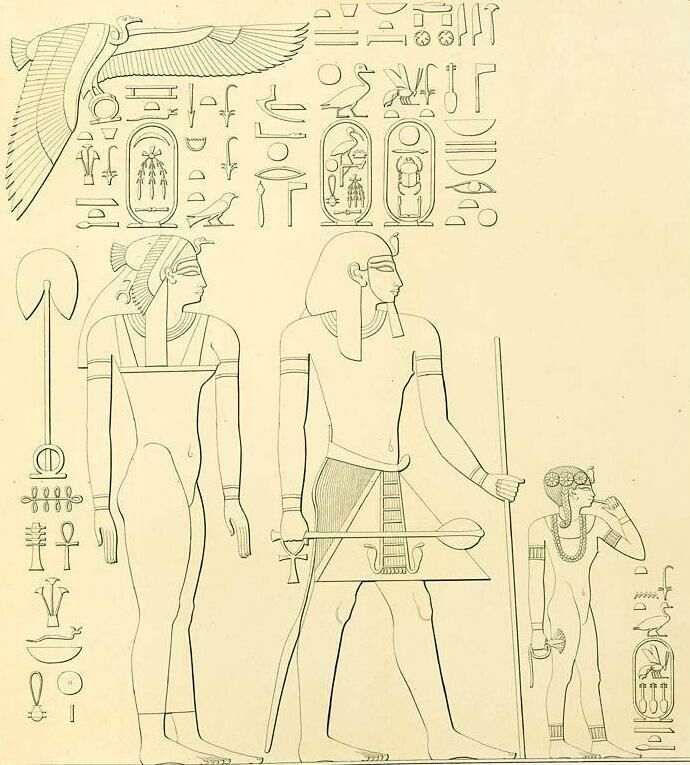
Among the detailed reliefs at Hatshepsut’s Deir el-Bahari mortuary complex is an image of her mother, Ahmose; father, Thutmose i; and sister, Nefrubity, depicted as a young girl. This image and accompanying hieroglyphic text is all that is known of her. After this, she completely disappears from the record—a typical assumption is that she died young.
Her name, Nefrubity, is interesting, consisting of two parts—Nefru and Bity (transliterated as nfrw bity). Nefru/nfr is a common name element meaning “beauty” or “beautiful.” Her sister Hatshepsut’s own daughter was named Neferu-re: “beauty of [the god] Re.” Her father Thutmose i’s minor wife’s name, Mut-nofret, means “[the goddess] Mut is beautiful.” On the extreme end of the spectrum, there is the famous 14th-century b.c.e. Queen Nefertiti—or in full, Neferneferuaten Nefertiti (“beautiful are the beauties of [the god] Aten, a beautiful woman has come”). The name element “Bity” could be translated as “bee”; also, this hieroglyph is representative of Lower Egypt (the location of the Land of Goshen, where the main body of Israelites dwelled). In point of comparison, the Hebrew name Bithiah is properly pronounced Bitya.
Could Nefrubity, then—“beautiful Bity”—be a name match for our princess Bithiah (Bitya) of the Bible? The name, dating, connection with the already-remarkable Hatshepsut, and even her disappearance from Egyptian records would be a good fit for the biblical account.
Article updated 16/6/25.

